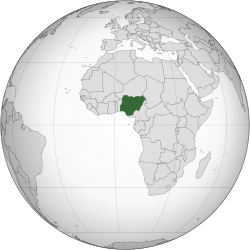Military dictatorship in Nigeria
| |||||||||||||||
| Motto: "Peace, Unity, Freedom"[1] (1966–1978) "Unity and Faith, Peace and Progress"[1] (1978–1979; 1983–1993; 1993–1999) | |||||||||||||||
| Anthem: Nigeria, We Hail Thee[1] (1966–1978) Arise, O Compatriots[1] (1978–1979; 1983–1993; 1993–1999) | |||||||||||||||
 | |||||||||||||||
| Capital | Lagos (1966–1979; 1983–1991) Murtala Mohammed | ||||||||||||||
• 1976–1979 | Olusegun Obasanjo | ||||||||||||||
• 1983–1985 | Muhammadu Buhari | ||||||||||||||
• 1985–1993 | Ibrahim Babangida | ||||||||||||||
• 1993–1998 | Sani Abacha | ||||||||||||||
• 1998–1999 | Abdulsalami Abubakarc | ||||||||||||||
| Chief of Staff / Vice President | |||||||||||||||
• 1966 | Babafemi Ogundipe (first) | ||||||||||||||
• 1998–1999 | Mike Akhigbe (last) | ||||||||||||||
| Legislature | None ( 1976 Nigerian coup d'état attempt | 13 February 1976 | |||||||||||||
| 1 October 1979 | |||||||||||||||
| 31 December 1983 | |||||||||||||||
| 27 August 1985 | |||||||||||||||
| 17 November 1993 | |||||||||||||||
| 29 May 1999 | |||||||||||||||
| Area | |||||||||||||||
| 1991[4] | 923,768 km2 (356,669 sq mi) | ||||||||||||||
| Population | |||||||||||||||
• 1991[4] | 88,514,501 | ||||||||||||||
| Currency | Nigerian pound (1966–1973) Naira (₦) (1973–1979; 1983–1993; 1993–1999) | ||||||||||||||
| Time zone | UTC+1 (WAT) | ||||||||||||||
| Driving side | left (until 2 April 1972)[5] right | ||||||||||||||
| ISO 3166 code | NG | ||||||||||||||
| |||||||||||||||
| Today part of | Bakassi peninsula ; governed by Nigeria until 2008 | ||||||||||||||
The military dictatorship in Nigeria was a period when members of the Nigerian Armed Forces held power in Nigeria from 1966 to 1999 with an interregnum from 1979 to 1983. The military was able to rise to power often with the tacit support of the elite through coup d'états. Since the country became a republic in 1963, there has been a series of military coups in Nigeria.
Background
The
Military regimes
- Heads of State of the military regimes
-
General Yakubu Gowon
-
Major General Muhammadu Buhari
-
General Ibrahim Babangida
-
General Abdulsalam Abubakar
Major General Johnson Aguiyi-Ironsi was made the Head of the Federal Military Government of Nigeria, serving for six months before being overthrown and assassinated in the 1966 Nigerian counter-coup.
Aguiyi-Ironsi was succeeded by General
The Second Republic was overthrown in the
General Ibrahim Babangida was promulgated as the President and Commander-in-Chief of the Armed Forces and established the Armed Forces Ruling Council. His rule was the longest serving peaceful administration typified as the military off dictatorship of the 20th century. Babangida promised a return of democracy when he seized power, but he ruled Nigeria for eight years, when he temporarily handed power to the interim head of state Ernest Shonekan in 1993.
In 1993, General
Transition to democracy
After Abacha's death in 1998, General
See also
- Nigerian First Republic
- Nigerian Second Republic
- Nigerian Third Republic
- Nigerian Fourth Republic
- Politics of Nigeria
References
- ^ ISBN 9781432788353.
- ^ ISBN 9780739109540.
- ^ ISBN 9780857730954.
- ^ a b Oshungade, I. O. (1995). "The Nigerian Population Statistics" (PDF). 1995 Directory of Nigerian Statisticians. 2: 58. Archived from the original (PDF) on 27 February 2013.
- ^ "Right-Hand/Left-Hand Driving Customs (mostly the change from Left to Right)". rammb.cira.colostate.edu.






